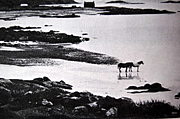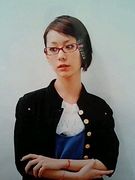ストランドに関するエッセイを翻訳でご紹介。。。
ほかに評論などコメント欄にてご紹介くださいませ。
◆◆◆
(下記、MOCP のページよりご紹介します。
できるときに和訳をつけていきたいと思っております。
ご意見、ご指摘などございましたら、
コメントやメッセージにてお願いいたします。)
Strand’s work is rooted in the best tradition of photography.
His vision is potential. His work is pure. It is direct. It does not
rely on tricks of process. In the history of photography there are but
few photographers, who from the point of view of expression, have really
done work of any importance. And by importance we mean work that has some
relatively lasting quality, the element which gives all art itself real
significance. —Alfred Stieglitz
Taking his inspiration from the Edgar Lee Masters’ 1915 Spoon River Anthology,
Paul Strand focused his career on photographing people in small, close-knit
communities. He made his regional photographs in widely varied places, including
the American Southwest and New England regions, Ireland, Italy, Mexico,
and France. Strand was particularly fascinated by bultos he observed in Mexico.
Carved wooden figures of Christ, the Madonna, and saints decorating rural churches,
the bultos expressed an impassioned faith Strand found impressive; he wrote
to a friend that he considered the works “among the most extraordinary
sculptures I have seen anywhere,” and believed that the world needed
an equally passionate faith. Although he spent much of his career taking
portraits, Strand also photographed nature and the environment, as in
Christo With Thorns, Huexotla.
Born in New York City in 1890, Paul Strand studied under Louis Hine at
the Ethical Culture School, where he developed an interest in photography.
Over time Strand developed a direct, sharp, and emotional style of straight
photography – an uncommon aesthetic before the rise of modernism beginning
around World War I. In 1945, the Museum of Modern Art in New York devoted
its first one-person photography show to his works. Strand also had a strong
interest in cinematography, making his first film in 1921 with Charles Sheeler
and continuing to produce films until 1943 when he decided to devote himself
exclusively to still photography. He died in France in 1976.
Adams, Robert, and Maren Stange. Paul Strand: Essays on his Life and Work. New York: Aperture, 1990.
Duncan, Catherine, Paul Strand, and Ute Eskildsen. Paul Strand: The World on my Doorstep: An Intimate Portrait. New York: Aperture, 1994.
Greenough, Sarah, and Paul Strand. Paul Strand: An American Vision. Washington: National Gallery of Art, in association with Aperture Foundation, 1990.
Hambourg, Maria Morris, and Paul Strand. Paul Strand, circa 1916. New York: The Metropolitan Museum of Art, distributed by H.N. Abrams, 1998.
Peeler, David P. The Illuminating Mind in American Photography: Stieglitz, Strand, Weston, Adams. Rochester, NY: University of Rochester Press, 2001.
Strand, Paul, Ansel Adams, et al. Paul Strand and Ansel Adams: Native Land and Natural Scene. Tucson: Center for Creative Photography, University of Arizona, 1990.
Strand, Paul, and Mark Haworth-Booth. Paul Strand. New York: Aperture Foundation, 1987.
Strand, Paul, Gerald P. Peters, and Megan Fox. Paul Strand: An Extraordinary Vision. Santa Fe, NM: Gerald Peters Gallery, 1994.
<引用先>
http://
|
|
|
|
|
|
|
|
Paul Strand 更新情報
-
最新のイベント
-
まだ何もありません
-
-
最新のアンケート
-
まだ何もありません
-
Paul Strandのメンバーはこんなコミュニティにも参加しています
人気コミュニティランキング
- 1位
- 写真を撮るのが好き
- 208260人
- 2位
- マイミク募集はここで。
- 89474人
- 3位
- お洒落な女の子が好き
- 89986人
























